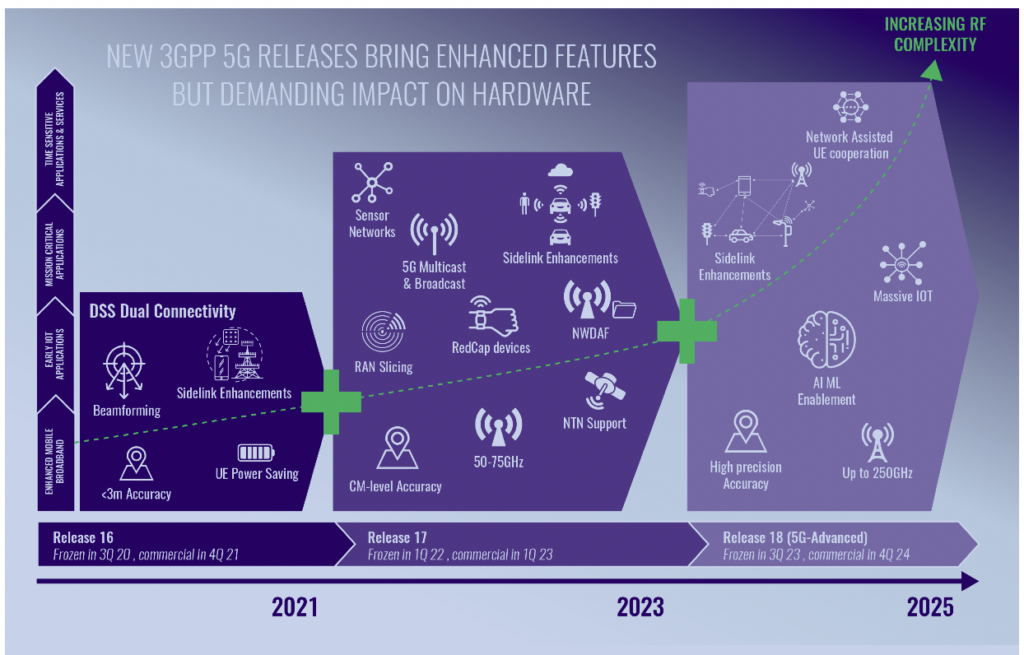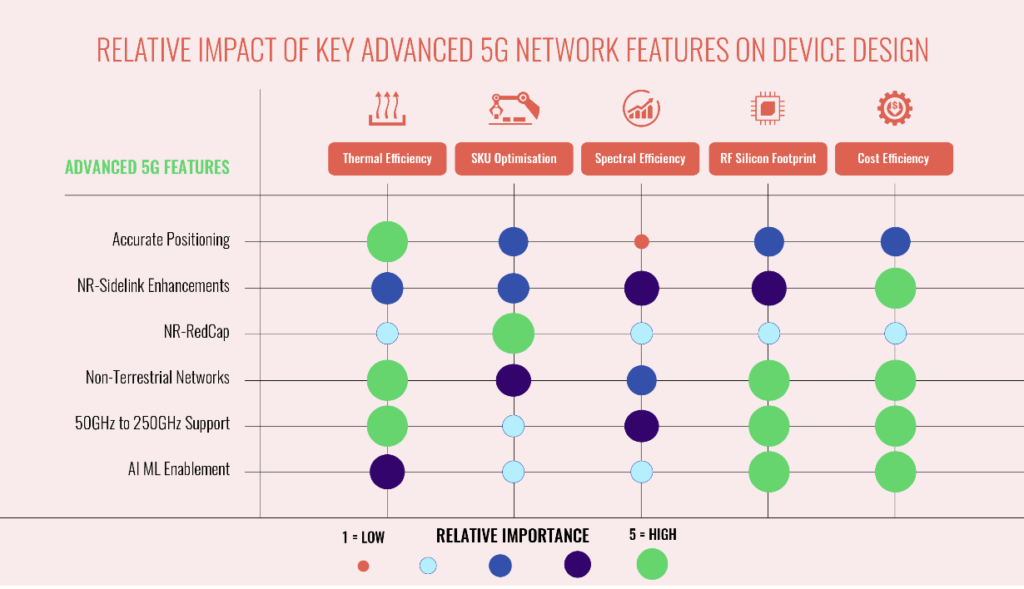The 5G industry has seen phenomenal growth over the past few years, but it is only just at the beginning of its journey. With the evolution toward 5G Advanced, there is still much to be done to fully unlock the value of the 5G ecosystem and realize its full potential. To help reach this promise, a roadmap of The 3rd Generation Partnership Project (3GPP) specifications will roll out in the coming years, expanding 5G New Radio (NR) into new industries and delivering system solutions for use cases beyond traditional mobile broadband services.
As a first stage in this new era, the 3GPP has already completed 5G NR Release 16 (Rel-16), which has unlocked many new 5G opportunities and brought enhancements to foundational aspects of the 5G system. This has included better coverage and system performance, lower latency, further reductions in device power consumption, reliability and efficiency, while also delivering other key transformative technologies, such as positioning with below 3-meter accuracy and sidelink for supporting autonomous vehicles.
These 5G enhancements will all be built upon by the imminent move to Release 17 (Rel-17) and 5G Advanced, specified under Release 18 (Rel-18), both of which will represent major 5G evolutions and support the continuous drive to new use cases, verticals and deployments. For both new releases, it is expected that several features will be incrementally improved and enhanced, while others will nominally address and widen new use cases, verticals and deployment options that are specific to the launch of each subsequent release.
As outlined in Figure 1, the new 3GPP releases and their timings outline enhancements to certain attributes, such as positioning with support of centimeter-level accuracy and latency below 100 Milliseconds (ms). Under Rel-17, some of the main new features include:
- Support for Non-Terrestrial Networks (NTNs), including satellite and non-public networks for extending connectivity to remote areas, including airspace, sea and land not covered by terrestrial communications, or traditional terrestrial communications networks.
- NR sidelink evolution with support for pedestrian safety through connecting smartphones and wearables directly to vehicles.
- Reduced Capacity (RedCap) devices to expand the growth of energy-constrained use cases, such as consumer or medical wearables, Industrial Internet of Things (IIoT) sensors or camera surveillance devices.
- Sidelink relay enhancements, whereby relay User Equipment (UE) connects one or more remote UEs to the network, or a relay UE connecting multiple remote UEs to each other. This is designed to alleviate network traffic by facilitating device-to-device communications through UE relays.
- Frequency bands beyond 52 Gigahertz (GHz) and up to 75 GHz, enabling mobile networks to offer hyper mobile broadband throughput beyond 20 Gigabits per Second (Gbps) in the downlink and 10 Gbps in the uplink.
- Multicast Broadcast Service (MBS) to enhance 5G NR capabilities to democratize the deployment of reliable, low-latency and resource-efficient MBS.
These new features will help next-generation 5G networks become ubiquitous and democratized, enabling global coverage and seamless and cost-effective telecommunications services, including public safety and mission-critical applications.
Moreover, the shift to Rel-18, which is a significant evolution that has been coined 5G Advanced, will build on Rel-17, providing intelligent network solutions. Notably, a major Rel-18 enhancement will be in the areas of Artificial Intelligence (AI) and Extended Reality (XR), based on Machine Learning (ML) techniques, to support a wider variety of use cases and more challenging applications. Other main functions include higher precision location accuracy, the creation of massive Internet of Things (IoT) and support for frequency bands up to 250 GHz.
While each of the new services and enhanced features that spring from these 3GPP releases will fundamentally grow the number of uses cases in the 5G ecosystem, at each stage, there will be an increasingly demanding impact on hardware as the opportunity extends beyond mobile broadband. This will have a major bearing on the preference, management and configuration of modem and component selection and packaging, with an added increase in number and complexity of the Radio Frequency Front End (RFFE) components and modules. In turn, adding such features will create additional product design considerations and constraints that will all need to be resolved, which adds yet another layer of complexity.
Figure 1: New 3GPP 5G Releases bring enhanced features, but demanding impact on hardware

As each of these the new advanced 5G features is released, they will not only have a bearing on networks, but also a lasting impact on many key metrics that are linked to the use of device components, system-level design and overall costs. Indeed, adding these new functions will place significant burden on the growth in new device designs, with some necessitating the use of additional hardware, for instance, supporting NTN networks or higher order Millimeter Wave (mmWave) spectrum beyond 50 GHz.
Specifically, there will be a need to add more components, notably as frequencies move above 6 GHz and improvements are made in positioning precision, as well as for NTN and MBS support. This needs to be achieved while also trying to minimize the number of device Stock Keeping Units (SKUs). Improved power efficiencies and management will also be fundamental requirements, particularly when in support of massive IoT, although there are expectations that this can be aided by input from the use of AI.
Some of these main 5G Advanced features are listed in Figure 2, notably accurate positioning, NTN, NR RedCap and AI/ML enablement, and shows for each their relative importance on metrics, such as thermal efficiency, RF silicon footprint and cost efficiency.
While a feature like NR-RedCap has minimal relative impact on design due to it fundamentally consisting of less complex, lower priced and more power-efficient devices, others like AI/ML enablement, NTN and NR-sidelink enhancements will all have a significant bearing and importance on system-level design. The relative higher importance of the key measurements across these functions requires more informed component choices to be made to ensure that these new advanced functionalities can maximize their impact on and extend 5G use cases and the wider ecosystem.
Figure 2: Relative impact of key advanced 5G network features on device design

With the advent of these new 5G Advanced features, and their impending impact on RFFE Key Performance Indicators (KPIs), most notably power consumption and optimization of modem and RFFE system selection, the industry needs to quickly come to grips with balancing the complexity inherent in the 5G Advanced system if it is to reach full potential. This is expected to ultimately move to the creation of an experience-centric 5G ecosystem and the industry will need to take some solid steps to make this a reality, which will be the concern of all stakeholders across the value chain. An experience-centric design moves devices to act as hubs that can support multiple devices, so a system-level design needs to support and be expanded beyond just the main hubs to address all device types.
Such an expansion in 5G use cases designed to unlock these advanced experiences will lead to the development of greater numbers of device form factors and market segments, and advances in those that need to be more fine-tuned and sophisticated, which will lead to a large increase in the volume of devices taking market growth way beyond mobile phones. The creation of these experiences is central to mobile services with the user positioned firmly in the middle surrounded by multiple devices that act as enablers, whether that device is a smartphone or tablet, automotive, set of wireless earbuds or a smartwatch. It is important that the industry’s mindset concerning 5G does not focus on the evolution of technology supply chains, but on the enablement of use cases and experiences to embrace the wider implications of moving the market to one that is experience-centric.
Figure 3: Balancing complexity: New 5G advanced features set to impact all RFFE components and designs

For the time being, the industry is just scratching the surface, taking its first steps to provide an explosion of enhanced 5G user experiences buoyed by the upcoming 3GPP releases, in terms of both planning for new use cases and opening new business opportunities.
Therefore, if the industry is to fully unlock value in the connected 5G economy, fulfilling its massive market potential, while moving beyond traditional mobile broadband services, the industry needs to be patient and execute on the promise of these innovative experiences, while also embracing and expanding the reach of 5G to new services, features, spectrum and deployments in the coming years.
The post Impact of new 5G specifications on radio frequency front end and modem designs (Analyst Angle) appeared first on RCR Wireless News.
